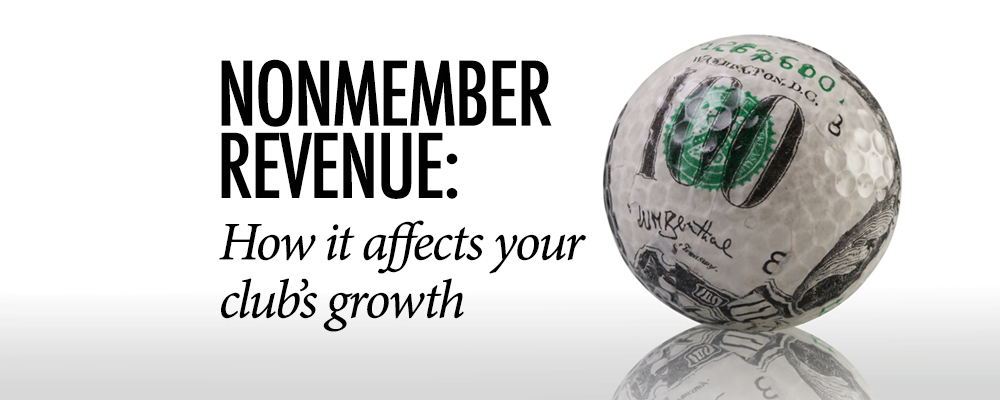How nonmember revenue can help advance, and impede, club growth
As the club industry continues to evolve between private member-owned clubs and public ones, the majority remain member-owned, focusing on the member’s experience rather than on public consumption. However, board of directors or governors of clubs are trying to fund operations without raising members’ dues while trying increase club use by nonmembers through offering nontraditional activities. But nonmember revenue is not the cure-all as nonmember use does not provide the needed revenue and may negatively impact club usage of the club by paying members.
It’s proven difficult to convince boards of this reality and as a result, many clubs are expanding the amount of nontraditional activity in which it engages and nonmember income is approaching or exceeding the limits established by the Internal Revenue Service for tax-exempt clubs. According to the 2018 issue of Clubs in Town and Country which is published by PBMares, LLP, 90 percent of clubs self-reported nonmember income. As tempting as extra cash might sound, there are several factors affecting the true cost of nonmember activity that must be evaluated.
The following can impact Nonmember Revenue on a Club’s Bottom Line
15/35 Rule
Gross receipts derived from the public using the club is the most observed consideration taken by management when considering nonmember revenues. Per IRS guidance, a 501(c)(7) a social club may receive up to 35 percent of its gross receipts from nonmember sources, including investment income. No more than 15 percent of gross receipts may be derived from nonmember use of club facilities and services. Although the limitations can be exceeded occasionally, the rule is in place to ensure “substantially all” club activities are for the “pleasure recreations and other nonprofitable purposes.” Receiving more than the IRS stipulated income can cause an examination or even termination of a club’s tax-exempt status.
Contented Membership
One of the main reasons clubs are successful is because, like other non-profits, the members come together under a mission. While a club’s mission is for members to socialize, golf, play tennis, etc., use by nonmembers can cause undue tension among those who are dues-paying members. The club must always consider if the nonmember activities by nonmembers are negatively impacting or inconveniencing the paid members. The number one priority of a member-owned club should be to always keep the paying members happy. Too much nonmember activity runs the risk of membership questioning why they joined a private club in the first place to pay for the upkeep of facilities for the use of others.
Indirect Costs
Clubs must consider all costs, including wear and tear on the facilities before permitting nonmember activity. For example, banquets are generally one of the more profitable nonmember activity but may impact the physical environment the most. In addition to the physical toll that nonmember activities can have on a club, there are also indirect administrative costs to consider as well.
- How much time is your banquets manager spending with a non-member event that is better spent elsewhere?
- How much are housekeeping costs for a room block from a non-member event?
If the aggregate of all costs exceeds the income, clubs need to really consider the benefit of public consumption.
After considering all the true costs of nonmember activity, Club’s should also consider some of the benefits that may outweigh the costs.
- Excess capacity – operating any business involves some aspect of sunk costs regardless of activity level. It may be offsetting those sunk costs with nonmember revenue is better than having excess capacity. Clubs should measure the excess capacities and put to use what provides the best possible outcome.
- Employee engagement – An “engaged employee” is one who is fully absorbed by and enthusiastic about his work and takes positive action to further the organization’s reputation and interests. Nonmember income can supplement not only cash flow but can also help stimulate and motivate employees to keep them engaged.
- Clubhouse lifestyle – clubhouse usage and grounds activities increase member energy and excitement. A lively clubhouse stimulates spending.
- Future members – advertising for private club membership is almost completely word of mouth. Nonmember events have the added bonus of becoming the newest member. It is common for clubs that are sensitive to outside influence to vet the membership of another club and permit their members to use their club as well. This can provide increased revenue with a minimum amount of interruption. While reciprocity is appreciated and respected, guests are still nonmembers and therefore their activity is still considered as non-member income. Many city clubs run into this problem since the hotel room rental are almost exclusively from reciprocal arrangements.
One final issue is privacy. Privacy is very important and goes beyond who you allow to enter the club. Privacy can impact operations, the application of certain federal laws and how the club is viewed in the community. States or municipalities with public accommodation laws, as well as the federal government, may be more willing to treat your organization as a “private” club if it is tax-exempt and limits the use of its facilities by the general public. Private clubs should operate for the benefit of its members.
As published in Boardroom Magazine, September/October 2018 Edition by Kevin F. Reilly, JD, CPA, CGMA and Mary F. Dolan, CPA of PBMares’ Hospitality Team





